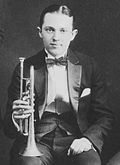
Leon Bismark "Bix" Beiderbecke (March 10, 1903 – August 6, 1931) was an American jazz cornetist, jazz pianist, and composer.
With Louis Armstrong and Muggsy Spanier, Beiderbecke was one of the most influential jazz soloists of the 1920s. His turns on "Singin' the Blues" and "I'm Coming, Virginia" (both 1927), in particular, demonstrated an unusual purity of tone and a gift for improvisation. With these two recordings, especially, he helped to invent the jazz ballad style and hinted at what, in the 1950s, would become cool jazz. "In a Mist" (1927), one of a handful of his piano compositions and one of only two he recorded, mixed classical (Impressionist) influences with jazz syncopation.
A native of Davenport, Iowa, Beiderbecke taught himself to play cornet largely by ear, leading him to adopt a non-standard fingering some critics have connected to his original sound. He first recorded with Midwestern jazz ensembles, The Wolverines and The Bucktown Five in 1924, after which he played briefly for the Detroit-based Jean Goldkette Orchestra before joining Frankie "Tram" Trumbauer for an extended gig at the Arcadia Ballroom in St. Louis. Beiderbecke and Trumbauer joined Goldkette in 1926. The band toured widely and famously played a set opposite Fletcher Henderson at the Roseland Ballroom in New York City in October 1926. He made his greatest recordings in 1927 (see above). In 1928, Trumbauer and Beiderbecke left Detroit to join the best-known and most prestigious dance orchestra in the country: the New-York-based Paul Whiteman Orchestra. (Full article...)